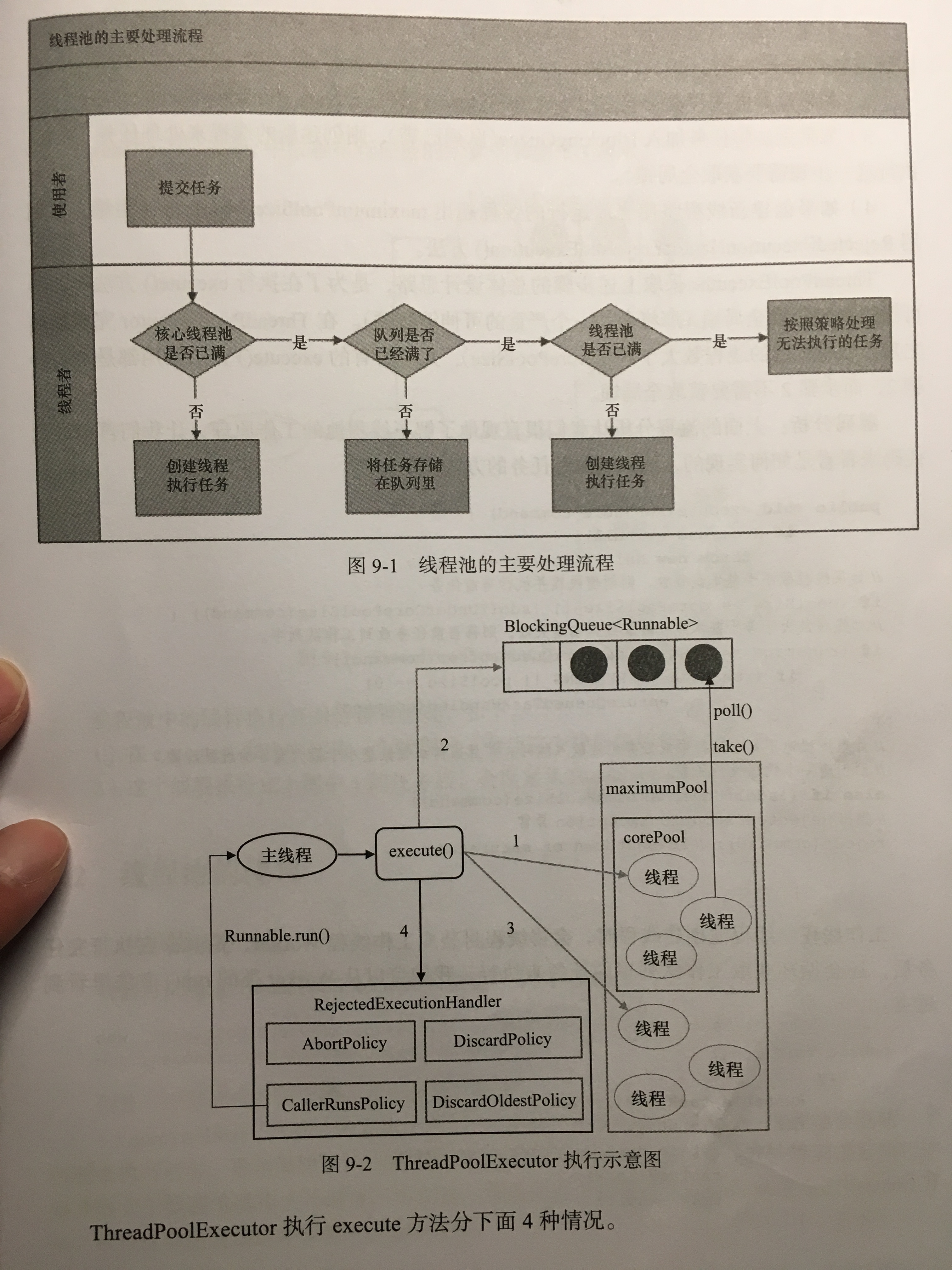实现原理
ThreadPoolExecutor执行execute:
- 如果当前运行的线程少于corePoolSize,则创建新线程来执行任务(需要获取全局锁)。
- 如果运行的线程等于或多余corePoolSize,则将任务加入BlockingQueue
- 如果无法将任务加入BlockingQueue(队列已满),则创建新的线程来处理任务(需要获取全局锁)。
- 如果创建新线程将使当前运行的线程超过maximumPoolSize,任务将被拒绝,并调用RejectedExecutionHandler.rejectedExecution()方法。

线程池的使用
创建
1 | public ThreadPoolExecutor(int corePoolSize, |
workQueue:任务队列(ArrayBlockingQueue、LinkedBlockingQueue、SynchronousQueue、PriorityBlockingQueue)
maximumPoolSize: 如果使用了无界的任务队列这个参数就没哟什么效果
RejectedExecutionHandler: 饱和策略
提交任务
execute: 无返回值
sumbit:有返回值1
2
3
4
5
6
7
8
9
10
11
12
13
14
15
16
17
18
19
20
21
22
23
24
25
26
27
28
29
30
31
32
33
34
35
36
37
38
39
40
41
42
43
44
45
46
47
48
49
50
51
52
53
54
55
56
57
58
59
60
61
62
63
64
65
66
67
68
69
70
71
72
73
74
75
76
77/**
* @throws RejectedExecutionException {@inheritDoc}
* @throws NullPointerException {@inheritDoc}
*/
public Future<?> submit(Runnable task) {
if (task == null) throw new NullPointerException();
RunnableFuture<Void> ftask = newTaskFor(task, null);
execute(ftask);
return ftask;
}
/**
* @throws RejectedExecutionException {@inheritDoc}
* @throws NullPointerException {@inheritDoc}
*/
public <T> Future<T> submit(Runnable task, T result) {
if (task == null) throw new NullPointerException();
RunnableFuture<T> ftask = newTaskFor(task, result);
execute(ftask);
return ftask;
}
/**
* @throws RejectedExecutionException {@inheritDoc}
* @throws NullPointerException {@inheritDoc}
*/
public <T> Future<T> submit(Callable<T> task) {
if (task == null) throw new NullPointerException();
RunnableFuture<T> ftask = newTaskFor(task);
execute(ftask);
return ftask;
}
protected <T> RunnableFuture<T> newTaskFor(Runnable runnable, T value) {
return new FutureTask<T>(runnable, value);
}
public void execute(Runnable command) {
if (command == null)
throw new NullPointerException();
/*
* Proceed in 3 steps:
*
* 1. If fewer than corePoolSize threads are running, try to
* start a new thread with the given command as its first
* task. The call to addWorker atomically checks runState and
* workerCount, and so prevents false alarms that would add
* threads when it shouldn't, by returning false.
*
* 2. If a task can be successfully queued, then we still need
* to double-check whether we should have added a thread
* (because existing ones died since last checking) or that
* the pool shut down since entry into this method. So we
* recheck state and if necessary roll back the enqueuing if
* stopped, or start a new thread if there are none.
*
* 3. If we cannot queue task, then we try to add a new
* thread. If it fails, we know we are shut down or saturated
* and so reject the task.
*/
int c = ctl.get();
if (workerCountOf(c) < corePoolSize) {
if (addWorker(command, true))
return;
c = ctl.get();
}
if (isRunning(c) && workQueue.offer(command)) {
int recheck = ctl.get();
if (! isRunning(recheck) && remove(command))
reject(command);
else if (workerCountOf(recheck) == 0)
addWorker(null, false);
}
else if (!addWorker(command, false))
reject(command);
}
通过线程池submit的任务,最终都被包裹成FutureTask,并且FutureTask实现了Runnable接口。
在调用execute方法后,将任务添加到工作队列中。
关闭线程池(shutdown、shutdownNow)
原理:遍历线程池中的工作线程,逐个调用线程的interrupt方法来终端,所以无法响应中断的任务可能永远无法终止。
区别:shutdown将线程池状态设为SHUTDOWN,然后中断所有没在执行的任务;shutdownNow首先将线程池的状态设为STOP,然后尝试停止所有正在执行或暂停任务的线程,并返回等待执行任务的列表。
合理配置线程池
任务特性
- 性质:CPU密集型任务、IO密集型任务、混合型任务
- 优先级:高中低
- 执行时间: 长、短
- 依赖性:依赖其他资源,入数据库连接
CPU密集型任务应配置尽可能小的线程,如配置coreNum + 1个线程的线程池。
IO密集型应配置尽可能多的线程,如2coreNum,由于不是一直在执行任务。
混合型的任务,如何可以拆分,将其拆分为一个CPU密集型任务和一个IO密集型任务,只要这两个任务执行的时间相差不是太大,那么分解后执行的吞吐量将高于串行执行的吞吐量。如果这两个执行时间相差太大,则没必要进行分解。
可以通过Runtime.getRuntime().availableProcessors()来获取当前设备的CPU个数。
建议使用有界队列,防止撑爆内存,拖垮系统,影响其他的任务。
线程池的监控
通过自定义线程池,重写线程池的beforeExecute、afterExecute和terminated方法,也可以在任务执行前、后和线程池给关闭前执行一些代码来进行监控。